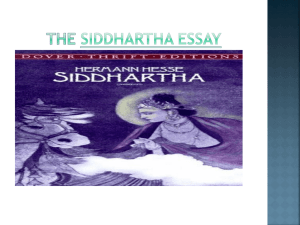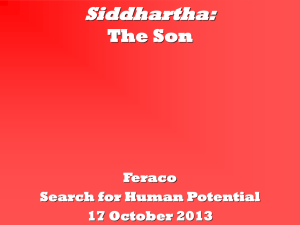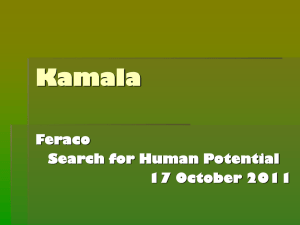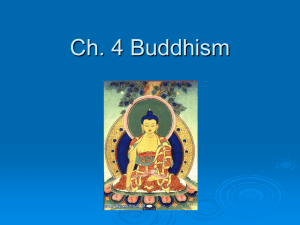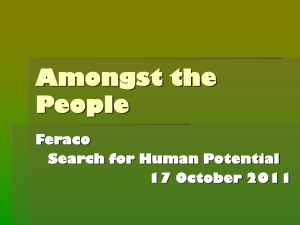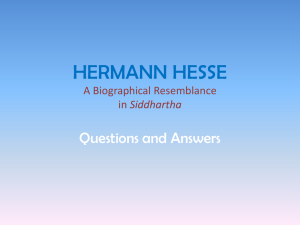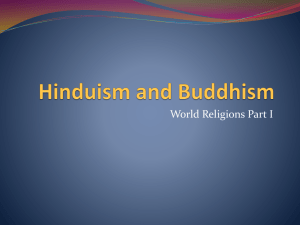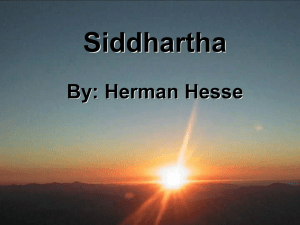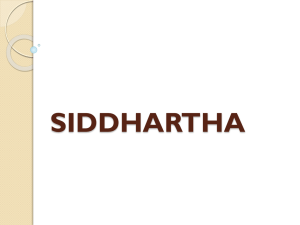Siddhartha
advertisement
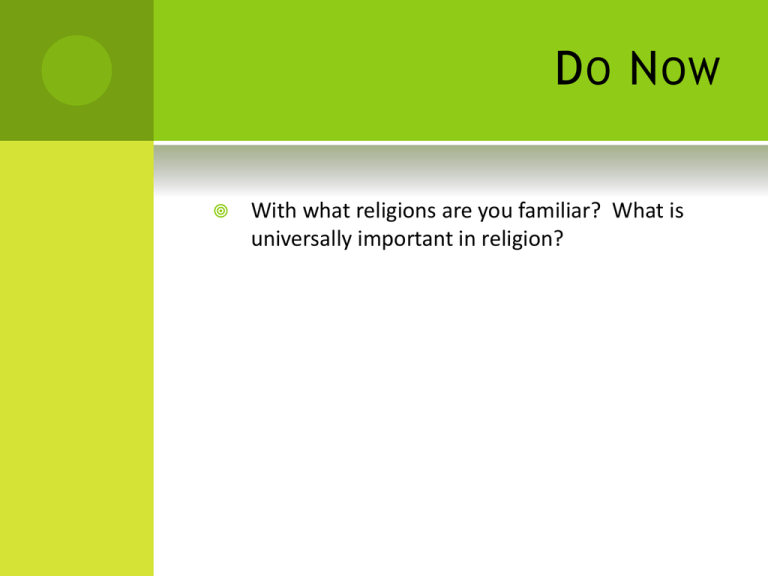
D O N OW With what religions are you familiar? What is universally important in religion? S IDDHARTHA T HEMES Self-discovery Spiritual quest Search for the Self Conflict: Person vs. self R ELIGIONS Siddhartha touches on four religions. Judaism Christianity Hinduism Buddhism H ERMANN H ESSE Born on July 2, 1877 in Calw in the Black Forest of Germany. His literary works reveal the influence of German romantic writers and the Hindu philosophy of India. His grandfather was a missionary in India and Hesse wrote that his grandfather’s stories greatly influenced him. Awarded the Nobel Prize for Literature in 1946. C LASSWORK Complete classwork worksheet. H OMEWORK Read Part 1 – The Brahmin’s Son and answer the corresponding questions. D O N OW How is Siddhartha similar to many teenagers in the chapter you read last night? J UDAISM Orthodox Judaism, Conservative Judaism, Reform Judaism Differences deal with different interpretations of religious texts, which result in differences in clothes, beliefs, and the role of women in the faith. J UDAISM One of the oldest major religions First religion to teach the belief in one God The roots of both Christianity and Islam are found in Judaism. A person serves God by studying the scriptures and practicing the teachings. Each congregation chooses their own rabbi. J UDAISM Basic laws and teachings The Torah The first five books of the Bible Contains the basic laws of Judaism and gives history of Jews until Moses’s death in the 1200s B.C. Talmud Collection of legal, ritual, and ethical writings, including Jewish history and folklore C HRISTIANITY Based on the life and teachings of Jesus Christ Belief in one God who created and takes care of the universe Three major groups Roman Catholic Protestant Eastern Orthodox C HRISTIANITY Basic laws and teachings The Bible, comprised of both the Old and New Testaments Clergy has varying degrees and authority, depending on the group. H INDUISM Major religion of India Dates back to prehistoric times in India One universal spirit called Brahman, the creator of the universe Vishnu, its preserver Shiva, its destroyer The soul never dies but is reborn through the process of reincarnation, based on the law of karma. H INDUISM Basic laws and teachings No single book but based on many sacred writings. The Vedas The Puranas The Ramayana The Mahabharata The Manu Smriti B UDDHISM Based on the teaching of the Buddha, whose real name was Siddhartha Gautama. Founded in India in 500 B.C. Existence is a continuing cycle of death and rebirth, determined by one’s behavior in a previous life. People can break out of the cycle of death and rebirth by eliminating attachment to all worldly things, thus attaining Nirvana. B UDDHISM Basic laws and teachings Tripitika A compilation of traditions built around the dharma (Buddha’s teachings) PART 1 – T HE B RAHMIN ’ S S ON Identify Siddhartha and Govinda and discuss their relationship. Discuss Siddhartha’s problem. For what is he searching? Why? Discuss Siddhartha’s decision and its impact on his father. PART 1 – T HE B RAHMIN ’ S S ON Discuss the impact of Siddhartha’s decision on Govinda. Analyze the symbolism of his father’s realization that Siddhartha “had already left him.” C LASSWORK Complete classwork worksheet. H OMEWORK Read Part 2 – With the Samanas and answer the corresponding questions. D O N OW What do you think of what we’ve read so far? Do you identify with Siddhartha at all? Or does the plot seem foreign to you? Explain. PART 2 – W ITH THE S AMANAS Examine the changes in Siddhartha following his alliance with the Samanas. What is one goal, and what does he do to attain the goal? Discuss whether or not he is successful in his quest. Analyze Siddhartha’s disillusionment with the Samanas in the search of his Self. Contrast Siddhartha’s and Govinda’s views of their spiritual journey. PART 2 – W ITH THE S AMANAS Discuss the description of Buddha and his effect on his world. Discuss Govinda’s hope and Siddhartha’s skepticism. Analyze what convinces Govinda that Siddhartha has absorbed the Samanas’ teachings. C LASSWORK Complete classwork worksheet. H OMEWORK Read Part 3 – Gotama and answer the corresponding questions. D O N OW How has Siddhartha’s experience with Gotama affected him? What changes do you see in his character? PART 3 - G OTAMA Discuss the various titles of Buddha and their significance. Discuss Govinda and Siddhartha’s impression of Buddha. Note the use of “peace” and “peaceful.” PART 3 - G OTAMA Analyze Buddha’s message and the response of Siddhartha and Govinda. Examine the conversation between Siddhartha and Buddha. What occurs? What has Siddhartha learned? What advice does Buddha give? Discuss Siddhartha’s resolve after his meeting with Buddha. Do you think Siddhartha will attain his goal? Is everyone in search of the Self? C LASSWORK Complete classwork worksheet. H OMEWORK Read Part 4 – Awakening and answer the corresponding questions. Do Now What has Siddhartha learned on his journey so far? PART 4 - AWAKENING Discuss Siddhartha’s self-reflection after he leaves Buddha. Analyze Siddhartha’s mental reflection “That was the last shudder of his awakening, the last pains of birth.” C LASSWORK Complete classwork worksheet. H OMEWORK Read Part 5 – Kamala and answer the corresponding questions. Do Now Why do you think people rely on religion to find fulfillment and peace? Explain. PART 5 - K AMALA Discuss how Siddhartha views the world after his decision to leave Buddha. Examine Siddhartha’s dream and its implication. Analyze the symbolism of the river to Siddhartha and the ferryman. Discuss Siddhartha’s first two encounters with women. PART 5 - K AMALA Discuss Siddhartha’s request of Kamala and the result of their encounter. Note her advice and his self-evaluation. Analyze the analogy Siddhartha draws between himself and a stone thrown into the water. C LASSWORK Complete classwork worksheet. H OMEWORK Read Part 6 – Amongst the People and answer the corresponding questions. D O N OW Make a list of 10 things you know about Siddhartha. Include physical characteristics, his experiences, his family and friends, his beliefs, and anything else you feel is important. PART 6 – A MONGST THE P EOPLE Examine the verbal exchange between Siddhartha and Kamaswami. What does this show you about each of the men? Analyze Siddhartha’s viewpoint, “Writing is good, thinking is better. Cleverness is good, patience is better” (53.) Correlate this with “If you cannot think, you cannot write, and if you cannot write, others will do your thinking for you.” PART 6 – A MONGST THE P EOPLE Contrast Kamaswami’s and Siddhartha’s views of business and life in general. Analyze the “soft, gentle inner voice” Siddhartha hears. How does your inner voice or conscience guide you? Analyze Kamala’s summation of Siddhartha, “You are the best lover I have had… And yet, my dear, you have remained a Samana” (59). Discuss how they are alike. C LASSWORK Complete classwork worksheet. H OMEWORK Read Part 7 – Samsara and answer the corresponding questions. Do Now How has Siddhartha’s experience with Kamala affected him? What changes do you see in his character? PART 7 - S AMSARA Discuss the changes in Siddhartha’s life. Do you think the changes are positive or negative? Have they brought him happiness? Analyze the “soul sickness of the rich” (63). Examine the vicious cycle of Siddhartha’s compulsion and its effect on him. Examine Siddhartha’s dream and its result. Analyze the symbolism of the songbird. C LASSWORK Complete classwork worksheet. H OMEWORK Read Part 8 – By the River and answer the corresponding questions. Do Now Siddhartha has realized the error of his previous ways and realizes his decisions have left him empty. What do you think has caused him to feel this way? PART 8 – B Y THE R IVER Analyze Siddhartha’s “death wish” and analyze the symbolism of “A chilly emptiness in the water reflected the terrible emptiness in his soul” (71). Contrast Siddhartha and Govinda when they meet by the river. Discuss the “wheel” of Siddhartha’s life. Analyze Siddhartha’s transformation and his analysis of the Self. C LASSWORK Complete classwork worksheet. H OMEWORK Read Part 9 – The Ferryman and answer the corresponding questions. Do Now Why do people go on journeys to find themselves as Siddhartha has done? What do you think they’re searching for? Explain. PART 9 – T HE F ERRYMAN Analyze Siddhartha’s revelation about the river and discuss its symbolism. Examine the effect living with Vasudeva has on Siddhartha and the effect of the two men on those who meet them. Discuss the pilgrimage to the dying Buddha and its effect on Siddhartha’s life. C LASSWORK Complete classwork worksheet. H OMEWORK Read Part 10 – The Son and answer the corresponding questions. Do Now What will become of Siddhartha and his son? How will having his son in his life now affect his search for the Self? PART 10 – T HE S ON Analyze the relationship between Siddhartha and his son. Discuss the universality of parents whose children reject their values. Discuss Vasudeva’s advice to Siddhartha about his son and why Siddhartha is unable to follow this advice. Discuss the boy’s running away and its aftermath. C LASSWORK Complete classwork worksheet. H OMEWORK Read Part 11 – Om and answer the corresponding questions. D O N OW What ideals do many religions have in common? What are fundamental, basic things that most people value in leading worthwhile lives? PART 11 - O M Analyze the repetition of the word “blind.” What are some types of “blindness” that everyone experiences? Discuss Siddhartha’s conclusion about wisdom. Examine the effect of Siddhartha’s seeing his reflection in the river. Analyze the effect of Siddhartha’s “confession” to Vasudeva and Vasudeva’s response. C LASSWORK Complete classwork worksheet. H OMEWORK Read Part 12 – Govinda and answer the corresponding questions. Do Now Why does it take Siddhartha so long to understand his life’s journey? Do you think he, like most people, could only understand the journey late in his life? Explain. PART 12 - G OVINDA Discuss Govinda’s state of mind when he returns to the river and Siddhartha’s explanation of his own search. Summarize Siddhartha’s conclusions about life. Analyze Govinda’s reception of Siddhartha’s philosophy. C LASSWORK Complete classwork worksheet. H OMEWORK Study for test.

